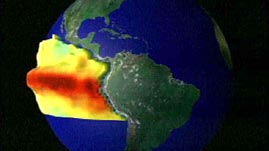Teachers' Domain - Digital Media for the Classroom and Professional Development
User: Preview

Source: NASA/Goddard Space Flight Center
The climatic phenomenon known as El Niño is a disruption of the ocean-atmosphere system in the tropical Pacific that impacts weather and climate around the globe. An El Niño occurs every four to twelve years, causes die-offs of plankton and fish, and affects Pacific jet-stream winds, altering storm tracks and creating unusual weather patterns around the world. This video segment adapted from NASA's Goddard Space Flight Center details some of El Niño's far-reaching effects on both marine life and humans.
Any disruption of the ocean-atmosphere system affects world weather. Perhaps no natural phenomenon illustrates this as well as an El Niño event. Although their origins may be particular to tropical latitudes, El Niños can shape climate on a global scale.
El Niño is a climatic phenomenon originally observed by fishermen, who noted the appearance of unusually warm currents off the coast of South America every few years. They also noticed that the warm water that arrives with El Niño events affected fishing harvests. During El Niño, a reduction in the normal upwelling of cool water means fewer nutrients enter the food chain, reducing ocean productivity.
In some years, the warm ocean current that flows south along the coasts of Ecuador and Peru in late December is warmer, stronger, and flows farther than usual. Because rainfall increases around warm water, the warmer current causes heavy rains to fall in normally dry areas along the western coasts of North, Central, and South America. The suspected cause of these unusual conditions is a slackening, and then a complete reversal, of the normal Pacific Ocean trade-wind pattern and its corresponding ocean currents.
Normally, trade winds blow from east to west and push water across the Pacific from South America toward Australia. As a result, when the trade winds are blowing, the water surface is actually several feet higher in the western Pacific than it is in the east. But when trade winds weaken, they no longer buttress the mass of warm water that typically builds in the western Pacific, and the force of gravity causes the water to surge back eastward.
Because rain that normally falls at western edge of the Pacific now falls instead along shores to the east, unusually dry conditions predominate over northern Australia, Indonesia, and the Philippines. Droughts take hold, crops fail, and food shortages follow. To the east, abnormally heavy rains fall along the shores of the Americas, and flooding threatens communities and erodes thin soils.
Scientists now know that El Niño events are the result of a large-scale weakening of the trade winds and warming of the surface ocean in the eastern and central equatorial portions of the Pacific Ocean. An El Niño event typically lasts 12-18 months and coincides with a swing in the Southern Oscillation (SO) — the see-sawing of tropical sea level pressure between the eastern and western hemispheres that occurs about every two or more years. The changes in the Southern Oscillation propagate the effects of an El Niño event around the globe.
El Niño's effects on global weather have proven consistent from event to event. Increased heating of the tropical atmosphere over the central and eastern Pacific affects the jet streams in the subtropics as well as in the temperate latitudes of the northern hemisphere, altering typical rainfall and temperature patterns in these regions.
 Loading Standards
Loading Standards Teachers' Domain is proud to be a Pathways portal to the National Science Digital Library.
Teachers' Domain is proud to be a Pathways portal to the National Science Digital Library.
